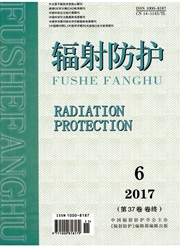

 中文摘要:
中文摘要:
为了对同时测量^222Rn、^220Rn子体浓度水平的五段法、二段法和α能谱连续测量法的特点和可靠性进行比较,在南华大学氡实验室用这三种方法进行了^222Rn、^220Rn子体浓度水平的同时测量。与二段法比较,五段法测量结果较准确,但由于测量时间长(10h以上)、测量段数多且操作麻烦,故不适合用于快速、大规模的测量;然而在高^222Rn、低^220Rn的建筑物中,用二段法测得的^222Rn子体α潜能浓度的误差较大。采用α能谱法的LCD-BWLM型^222Rn、^220Rn子体测量仪,具有操作方便、能区分能量及连续测量等优点,但它需要开机8h以上才能得到较准确的^220Rn子体浓度测量结果。对于^220Rn子体浓度变化很大的实际环境,LED-BWLM型仪器测得的^220Rn子体水平结果不够准确,且该仪器在重启的同时要更换新的滤膜。
 英文摘要:
英文摘要:
For comparing characteristics and accuracy of different methods, the simultaneous measurements of radon and thoron progeny were done using five-count filter method, two-count filter method and spectroscopy method in the Radon Key Lab of Hunan Province. Five-c ount filter method is more accurate than two-count filter method, however it is difficult to adopt five-count filter method for survey of environmental radon and thoron progeny in batches because of its longer measuring period (above 10 h) and more counts. The errors of two-count filter method are large in condition of concentration of thoron progeny higher than that of radon progeny. LCD-BWLM alpha spectroscopy method has some advantages such as simple operation, discrimination of α particles emitted from different nuclear, continuous measurement and so on, but the measurement results of thoron progeny are not reliable before measuring eight hours and under condition of variational thoron progeny. Filter must be newed when the instrument is restarted.
 同期刊论文项目
同期刊论文项目
 同项目期刊论文
同项目期刊论文
 期刊信息
期刊信息
